Heritage & Traditions at Aquinas College
1940 to 1949
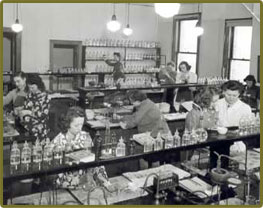
Students at work in the 1940s science lab. The large number of women reflect the war years when male students were serving in the Armed Forces.
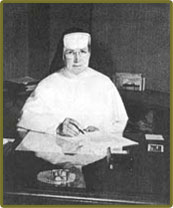
Sr. Mildred Hawkins, Academic Dean
1940
The Dominican sisters enter into negotiations with the North Central Association to expand Catholic Junior College into a four-year college. In 1939, a third year is added to CJC's curriculum. and in 1940, Catholic Junior College officially becomes Aquinas College, a four-year degree granting institution. The name Aquinas was chosen to honor both the medieval philosopher Thomas Aquinas and to remind the college of Mother Aquinata Fiegler whose leadership in the early years of Novitiate Normal School helped the original sisters establish their ministry in Michigan.
1941
Articles of incorporation for Aquinas College are officially filed in Lansing.
1942
WWII calls most male students into service. Recruiting days are held on campus and
several male faculty members enter the service. On the home front, students collect
pennies for copper salvage, sell war stamps and bonds, pray and hear Masses for the
armed forces. A service flag, dedicated on November 5, 1942, contains 114 blue stars
and one gold star, blue for those in service and gold for those who died. By December,
1944, the flag has 273 blue stars and 6 gold.
General education requirements totaled 70 semester hours, including Latin and Greek.
Summer courses are taught at Marywood, for the convenience of the Dominican sisters
who taught at Catholic schools during the school years and completed their degrees
in summer sessions.
Religious events through the year include an annual crowning of Mary in May, and a
celebration of the feast of Thomas Aquinas on March 7.
1944 to 1945
 In 1944, the first Aquinas College prom is held. Even though World War II is on (note
student in uniform and Sam Brown belt), students find time for fun.
In 1944, the first Aquinas College prom is held. Even though World War II is on (note
student in uniform and Sam Brown belt), students find time for fun.

Holmdene, the former Lowe mansion on the Robinson Road campus. Its 22 rooms housed most of the college’s functions in the early years. Included were offices, library, bookstore, with former bedrooms upstairs serving as classrooms. The mature trees in front of the mansion reflect the Lowe family’s lumbering interests and many of the trees on campus are rare species. There was at least one tree of every species that grows in Michigan as well as imported beeches from England, maples from Norway, and many elm trees, later wiped out by the blight.
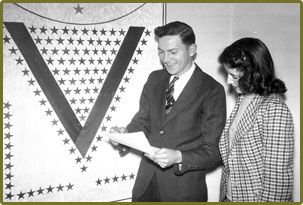
In December 1944, students Edmund Kieras and Betty Butler check out Aquinas College’s World War II service flag. Six Aquinas students were killed while serving in World War II.
 To hear an alumna from 1945 speak about the move to Holmdene and student hijinks, click here. This audio link is to "Historically Speaking," an oral history of Aquinas College.
To hear an alumna from 1945 speak about the move to Holmdene and student hijinks, click here. This audio link is to "Historically Speaking," an oral history of Aquinas College.
1945
Purchase of Robinson Road Campus, the former Lowe estate. This property was once owned by the short-lived University of Grand Rapids which went under financially during the war. Mother Euphrasia Sullivan spearheaded the purchase, taking out a loan of $115,000. In April, 1945, Father Bukowski announces the College’s move.

 To hear Sr. Jean Milhaupt reflect on the announcement and on how she scooped the diocesan
paper as a young reporter, click here for an audio clip from "Historically Speaking," an oral history of Aquinas College.
To hear Sr. Jean Milhaupt reflect on the announcement and on how she scooped the diocesan
paper as a young reporter, click here for an audio clip from "Historically Speaking," an oral history of Aquinas College.
Summer: The Holmdene manor house was readied for incoming students.
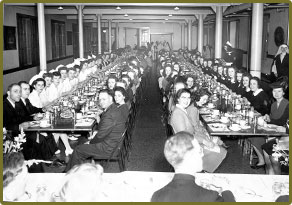
In 1945, Aquinas College purchased property at 1607 Robinson Road that included the stately Holmdene mansion built by Edward Lowe in 1908.
At left: Academic Day Breakfast 1945
1946 to 1947
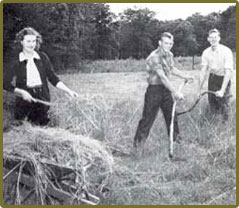 In 1945, when the College moves from the Ransom Street campus, there is much work
to be done to convert the former Lowe estate into a college campus. Here Aquinas students
work with scythes to clear away a field of hay.
In 1945, when the College moves from the Ransom Street campus, there is much work
to be done to convert the former Lowe estate into a college campus. Here Aquinas students
work with scythes to clear away a field of hay.
 In 1947, students on a budget learn to entertain themselves with an annual "Review-Preview"
and other activities.
In 1947, students on a budget learn to entertain themselves with an annual "Review-Preview"
and other activities.
1946
Aquinas College receives accreditation from the North Central Association.
The first yearbook is published and named "The Thomist."
The Aquinas Circle, a social club founded by German-born Father Henry Nauer, meets
weekly at the Knights of Columbus hall downtown.
Enrolment swells to 426 students as 144 returning World War II vets come back to campus.

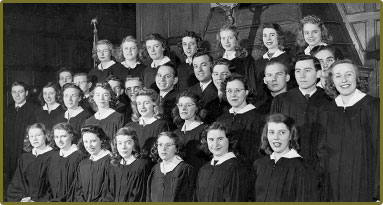 To hear alumna Millie de Alva Marin discuss the effect of the returning vets on the
college, click here for an audio clip from "Historically Speaking," an oral history of Aquinas College.
To hear alumna Millie de Alva Marin discuss the effect of the returning vets on the
college, click here for an audio clip from "Historically Speaking," an oral history of Aquinas College.
At left: The College Glee Club, 1947, poses in Holmdene lobby
1948 to 1949
 Before the Administration building was constructed, nearly all college activities
were housed in Holmdene. Here students work in the library in Holmdene in 1948.
Before the Administration building was constructed, nearly all college activities
were housed in Holmdene. Here students work in the library in Holmdene in 1948.
 1949 Aquinas basketball team. The Aquinas sports program in these days is limited
to baseball, basketball, golf, cross-country and track.
1949 Aquinas basketball team. The Aquinas sports program in these days is limited
to baseball, basketball, golf, cross-country and track.
1948
Father Bukowski is elevated to the status of Monsignor.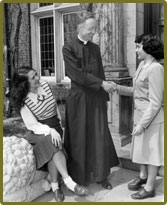
Students form a chapter of the Dominican Tertiaries (3rd order), and plan construction of the shrine of Our Lady of Fatima (dedicated May, 1950). The money for the shrine was raised by students and alumni in memory of the Aquinas community members who died in World War II.
The first Marian Congress is held, May 1. This annual event draws crowds of more than 2,000 people each year.
 To hear alumnus Tom Zoellner talk about the construction of the Fatima shrine, click here. This audio link is to "Historically Speaking," an oral history of Aquinas College.
To hear alumnus Tom Zoellner talk about the construction of the Fatima shrine, click here. This audio link is to "Historically Speaking," an oral history of Aquinas College.

Graduation day, 1949, is held in the gym, the upper level of the old stables.
Note the angled ceiling which provides for interesting "carom shots" in basketball and volleyball games!
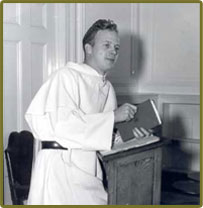
Father Terrier
CONTACT INFO
AQ History
Ryan Wendt
aqhistory@aquinas.edu